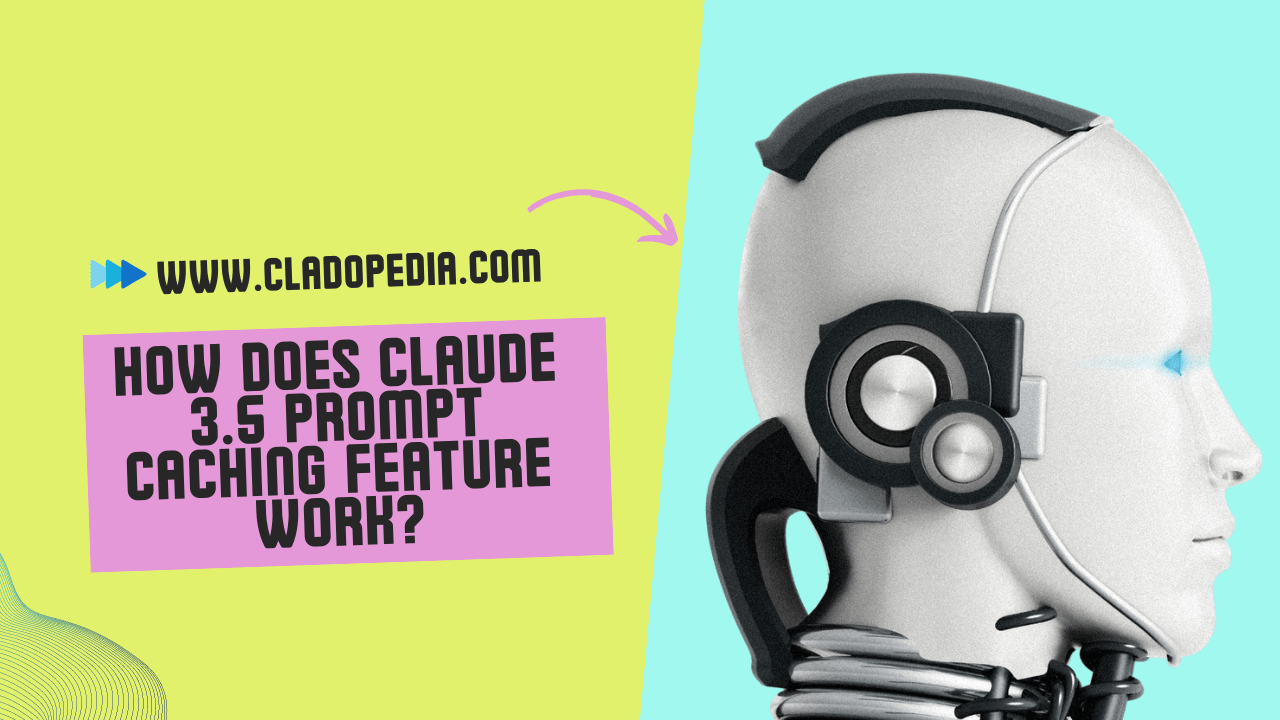How Does Claude 3.5 Prompt Caching Feature Work? Claude 3.5 is one of the latest advancements in the field of artificial intelligence, developed by Anthropic. This model represents a significant leap forward in AI capabilities, offering enhanced language understanding, context retention, and the ability to generate more accurate and contextually relevant responses. One of the key features introduced in Claude 3.5 is the Prompt Caching feature, designed to improve efficiency and response times for frequently used prompts.
Importance of Prompt Caching in AI Models
Prompt caching is a crucial mechanism in AI models like Claude 3.5, as it directly impacts the model’s performance, especially in real-time applications. By caching frequently used prompts, the AI can reduce latency, optimize resource usage, and enhance the user experience. This feature is particularly valuable for businesses and developers who rely on AI for high-volume interactions, such as customer support, content generation, and other automated tasks.
What is Prompt Caching?
Definition and Basic Concept
Prompt caching in AI refers to the process of storing the results of frequently used prompts in a cache, which is a temporary storage area. When a cached prompt is requested again, the AI retrieves the stored result instead of processing the prompt from scratch. This reduces the need for repetitive computation, leading to faster response times.
How Prompt Caching Differs from Regular Caching
Regular caching typically involves storing static data, such as images or web pages, to speed up retrieval times. In contrast, prompt caching involves storing dynamic content generated by AI models. This content is often context-sensitive and may involve complex processing, making prompt caching a more sophisticated and resource-intensive process.
Advantages of Using Prompt Caching in AI
The primary advantages of prompt caching include:
- Reduced Latency: By retrieving cached responses, the AI can deliver results more quickly.
- Lower Computational Load: Prompt caching reduces the need for repeated processing, freeing up computational resources for other tasks.
- Improved Scalability: With efficient caching, AI models like Claude 3.5 can handle larger volumes of requests without degrading performance.
- Cost Efficiency: Reduced processing translates to lower energy consumption and operational costs, particularly in cloud-based environments.
How Claude 3.5 Implements Prompt Caching
Architecture Overview
Claude 3.5’s architecture is designed to seamlessly integrate prompt caching. It consists of several key components:
- Prompt Processor: Handles the initial processing of prompts and generates responses.
- Cache Manager: Manages the storage and retrieval of cached prompts.
- Memory Module: Stores cached data and manages the lifecycle of cached entries.
The Role of the Cache Manager
The cache manager is central to the prompt caching process. It determines which prompts should be cached based on frequency of use and computational cost. The cache manager also handles cache invalidation, ensuring that outdated or irrelevant prompts are removed from the cache to maintain accuracy.
Memory Allocation for Caching
Claude 3.5 allocates a portion of its memory specifically for caching. The size of the cache is configurable, allowing users to optimize it based on their specific needs. Memory allocation is dynamic, meaning that it can be adjusted in real-time to accommodate varying workloads.
Data Retention and Expiry Policies
Prompt caching in Claude 3.5 is governed by data retention and expiry policies. Cached prompts are retained for a predefined period or until they are no longer relevant. Expiry policies are based on factors such as the prompt’s age, frequency of use, and changes in the underlying data or model parameters.
How Prompt Caching Enhances Performance
Speed Improvements
One of the most noticeable benefits of prompt caching is the significant improvement in response times. By eliminating the need to reprocess prompts, Claude 3.5 can deliver results much faster, which is especially beneficial in time-sensitive applications.
Resource Optimization
Prompt caching optimizes resource usage by reducing the demand on processing units and memory. This allows Claude 3.5 to handle more concurrent requests, making it more efficient in high-demand environments.
Scalability and Load Balancing
With prompt caching, Claude 3.5 can scale more effectively. By offloading repetitive tasks to the cache, the system can maintain performance levels even as the number of users or requests increases. This also aids in load balancing, as cached prompts can be distributed across multiple servers or nodes, reducing the risk of bottlenecks.
Use Cases of Claude 3.5’s Prompt Caching
Customer Support Automation
In customer support applications, certain queries are frequently repeated. Prompt caching allows Claude 3.5 to quickly provide accurate responses to these common questions, improving customer satisfaction and reducing wait times.
Content Generation
For content generation tasks, prompt caching can store the results of commonly requested formats or templates. This enables Claude 3.5 to generate content more quickly, which is particularly useful in scenarios where similar content is produced regularly, such as newsletters, reports, or social media posts.
Educational Tools
In educational applications, prompt caching can be used to store responses to frequently asked questions or explanations of common concepts. This ensures that students receive prompt, accurate feedback, enhancing the learning experience.
Personalized Recommendations
Prompt caching is also useful in applications that involve personalized recommendations. By caching responses for common user preferences or behaviors, Claude 3.5 can deliver tailored suggestions more efficiently.
Managing and Configuring Prompt Caching
Setting Up Caching Parameters
Claude 3.5 allows users to configure caching parameters, such as cache size, retention policies, and priority levels. These settings can be adjusted based on the specific needs of the application, ensuring that prompt caching is optimized for performance and resource usage.
Monitoring and Analytics
To ensure that prompt caching is functioning effectively, Claude 3.5 provides monitoring and analytics tools. These tools allow users to track cache hit rates, response times, and resource utilization. By analyzing this data, users can fine-tune their caching strategies to maximize efficiency.
Cache Invalidation Strategies
Cache invalidation is a critical aspect of prompt caching. Claude 3.5 employs several strategies to ensure that outdated or irrelevant prompts are removed from the cache. These strategies include:
- Time-Based Expiry: Prompts are automatically removed after a certain period.
- Usage-Based Expiry: Less frequently used prompts are purged to make room for more relevant ones.
- Manual Invalidation: Users can manually invalidate specific prompts based on changes in data or requirements.
Challenges and Limitations of Prompt Caching
Cache Staleness
One of the primary challenges of prompt caching is cache staleness, where cached responses become outdated due to changes in data or model parameters. This can lead to inaccurate or irrelevant responses.
Memory Management
Efficient memory management is crucial for prompt caching. If the cache size is too small, it may not store enough prompts to be effective. Conversely, if it’s too large, it could consume excessive resources, impacting overall system performance.
Security and Privacy Concerns
Caching sensitive data can raise security and privacy concerns, especially in applications involving personal information. Ensuring that cached prompts are encrypted and securely managed is essential to mitigate these risks.
Balancing Cache Hit Rates and Performance
Achieving a high cache hit rate while maintaining performance is a delicate balance. A low hit rate means that the cache is not being effectively utilized, while a high hit rate with poor performance could indicate issues with cache management or system resources.
Future of Prompt Caching in AI Models
Integration with Advanced AI Features
As AI models continue to evolve, prompt caching is expected to become more integrated with other advanced features, such as contextual understanding and real-time learning. This integration will enhance the effectiveness of caching by making it more adaptive and intelligent.
Automated Cache Management
Future developments in prompt caching may include automated cache management systems that use AI to dynamically adjust caching parameters based on real-time analysis of usage patterns and system performance.
Enhanced Security Measures
As security and privacy concerns become more prominent, future versions of prompt caching systems are likely to incorporate enhanced security measures, such as advanced encryption techniques and stricter access controls.
Broader Adoption Across Industries
As the benefits of prompt caching become more widely recognized, it is expected to see broader adoption across various industries, particularly in sectors that rely heavily on AI-driven automation, such as finance, healthcare, and e-commerce.

Conclusion
Recap of Prompt Caching Benefits
Prompt caching is a powerful feature of Claude 3.5 that significantly enhances the model’s performance by reducing latency, optimizing resource usage, and improving scalability. By understanding how prompt caching works and how to effectively manage it, users can unlock the full potential of Claude 3.5 in their applications.
The Future of AI with Prompt Caching
As AI technology continues to advance, prompt caching will play an increasingly important role in ensuring that models like Claude 3.5 can meet the demands of modern applications. By staying informed about the latest developments in prompt caching, users can ensure that they are leveraging this feature to its fullest extent, paving the way for more efficient and effective AI-driven solutions.
FAQs
1. What is the prompt caching feature in Claude 3.5?
Prompt caching is a feature in Claude 3.5 that stores the results of frequently used prompts in a cache, allowing for faster retrieval and reducing the need for repeated processing.
2. How does prompt caching improve performance?
It reduces latency by retrieving cached responses quickly, optimizes resource usage, and allows the system to handle more requests efficiently, improving overall performance.
3. Can I configure the prompt caching settings?
Yes, you can adjust parameters like cache size, retention policies, and priority levels to suit your application’s needs.
4. What happens if a cached prompt becomes outdated?
Claude 3.5 uses cache invalidation strategies, such as time-based expiry and usage-based expiry, to remove outdated or irrelevant prompts from the cache.
5. Are there security concerns with prompt caching?
Caching sensitive data can raise security concerns, so it’s essential to ensure that cached prompts are encrypted and securely managed.
6. How does Claude 3.5 handle memory allocation for caching?
Claude 3.5 dynamically allocates memory for caching, allowing adjustments in real-time based on workload demands.
7. What types of applications benefit most from prompt caching?
Applications involving high-frequency interactions, such as customer support automation, content generation, and personalized recommendations, benefit significantly from prompt caching.
